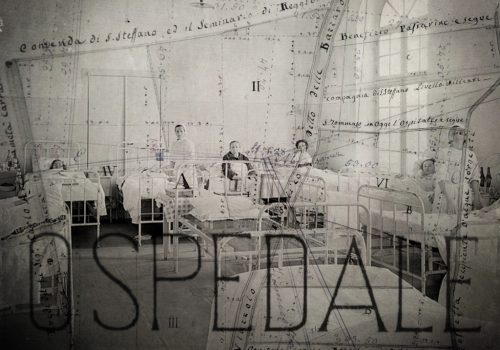A hospital is a body consisting of many different lives, stories of men on the front line or remaining forever behind the scenes. Stories of trepidations and relief, endeavour and courage. Fotoscopia narrates the conquest of a better rate of life and the capacity to examine the most unfigurable microscopic space. The work, consisting of small piles of translucent plates, includes suggestive representations where the photographic print rediscovers its chemical nature. Thus the spectacular beauty of diagnostic methods shines, exhibited to celebrate the explorative propulsion of the Arcispedale Santa Maria Nuova of Reggio Emilia (Italy) and the fifty years since it was founded. The photographer has the task of recounting the salient facts: a task that is brought to completion without the pretentions of documentary faithfulness, but instead tries to summarise the decades through symbolic images that crash through the personal sphere and scatter them into the abyss. It is all written in the plates of Alessandra Calò, but a clinical eye is needed to discern between truth and suspicion when attempting to interpret the shapes. This is the story of the origin of a grandiose project that started in the 1940s, the pillars of which embody the harmony of the human skeleton. A design that, in part, takes into consideration the importance of air, water and places: the teachings of Hyppocrates are still valid, according to which a medic must reflect on the position of a city on earth, “on the orientation both with respect to the winds and to the rising of the sun”. In one of the images, a graphic shows the disposition of the rooms with respect to the cardinal points, interweaved with the lines of the thoracic cage.
In this work the place manifests itself in all its aspects, from an architectural creation to an organised structure, from a research centre to a scene of changing eras. In Alessandra Calò’s work, the archived topographies find a place without hierarchies and the exegetic sketches of the doctors, mammography screenings and waiting room goldfish. Every decade has its ailments and therapies. The arrival of HIV, so disturbing that it required a new level of caution in every procedure, is recalled through the image of considerable social awareness advertising. The discovery of the endoscopy, with its infinitely small, dark circular vision, is alluded to with circle of moonlight in a dark night. Research into materials – conducted among the departments in dozens of interviews with physicians, nurses, technicians and attendants – followed a “domestic” approach, useful to represent a space where the life of the community continues in its daily rhythms, broken lightbulbs get changed, old sheets are used as rags, as in any private home. By using the art of appropriation, the photographer uses repertory images that adorn the corridors of the hospital, and accepts the challenge to reveal the aesthetic value of a patented imaging only to describe and to reveal. As in her other work, Alessandra Calò rewrites the original materials to give them a new and interim universal meaning. In the care of her vision, every era suspends its temporal dimension and goes on to represent the human condition in its constant fragility. Any innovation acquires a classic flavour, whereas history follows its course: one day grass will grow even on the linear accelerator.
Mainly captured with the use of iphoneography, but printed using ancient methods, the photoscopic images of Alessandra Calò do not accept representing reality within the limits of digital distance. Rather, they go back in time until they recover the comfort of touch, the reliability of a skilled technique, like that of a doctor who understands touch, a surgeon who manipulates his scalpel with a technology that is full of compassion. To this degree of humanity, mass reproduction becomes impossible and each plate acquires an identity from drools, from the inevitable distortions indicating our humanity: representation takes the risk of being unique, marked by a personal fate. Neither doctor nor photographer can boast total cybernetic control; but the more fate targets the individual, more the city embraces them in its care. In the images of “Fotoscopia”, the material superimposition of levels smashes through the space and gives the work a slight scenographic threedimensionality in which each can set their own inevitable memories. Everything is visible within the glass plates: here a history that belongs to all is preserved, from the sick to the hypochondriac, to the occasional visitor and every doctor or nurse who – like everyone – grows and ages. Each day, they meet each other along the “colour course” interweaving between floors and corridors according to a rational principle, but no-one wears the shirt anymore when their back is straight, so the photoscopy comes out well.
Diagnostic transparency exposes secrets that invite a medical examination: outside a hospital without walls, designed to amalgamate it with the city in a process of osmosis, doctor and patient stop their own otherness, they rise up from duty of being a body in order to accept responsibility for the humanity in the clinic. Neither doctor nor patient know the code of this examination that has never been seen before. Within the plates we will learn to read the signs of representation, each recognising how much the hospital looks like us.
Technical description: photographic print on glass ultra light
techniques used: silver salts, calotype, inkjet
dimensions: cm 20 x 20 x 3
year of realization 2015
















